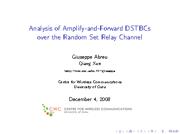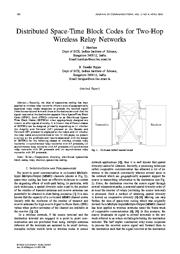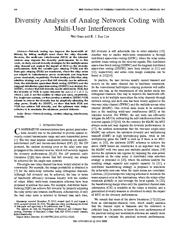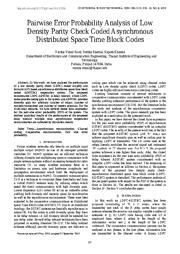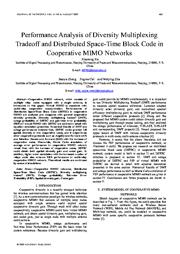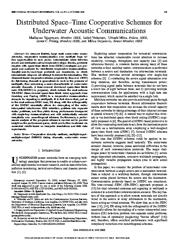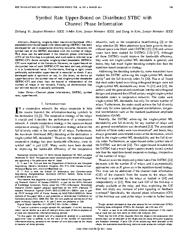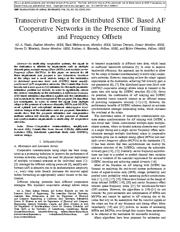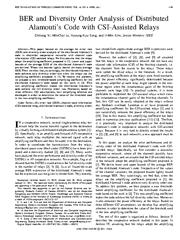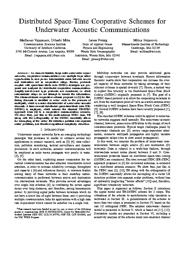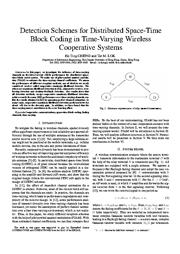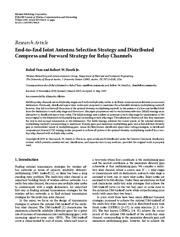A copy of this work was available on the public web and has been preserved in the Wayback Machine. The capture dates from 2017; you can also visit the original URL.
The file type is application/pdf.
Filters
Analysis of amplify-and-forward DSTBCs over the random set relay channel
2008
2008 42nd Asilomar Conference on Signals, Systems and Computers
Abreu, "Distributed GABBA space-time codes in amplify and forward relay networks," in IEEE Sensor Array and Multichannel Signal Processing Workshop (SAM'08), Darmstadt, Germany, Jul.21-23 2008.
[• Jafarkhani ...
: µ z (−s; ξ) = 1 s e ξ+ 1 s E 1 (ξ + 1/s) BER of Regular AF-DSTBC over the RSRC • General expression P X (γar,γ rb ; ξ,η,N,M ) = N X K=0 pK (ξ,N ) ·P X (γar,γ rb ; ξ, ηK, M ) • With PSK: P PSK = M −1 ...
doi:10.1109/acssc.2008.5074662
fatcat:fssxvkcmjfaljkmatu4ginw37i
Distributed Space-Time Block Codes for Two-Hop Wireless Relay Networks (Invited Paper)
2010
Journal of Communications
It is known that different classes of DSTBCs can be designed primarily depending on (i) whether the Amplify and Forward (AF) protocol or the Decode and Forward (DF) protocol is employed at the relays and ...
Recently, the idea of space-time coding has been applied to wireless relay networks wherein a set of geographically separated relay nodes cooperate to process the received signal from the source and forward ...
Sundar Rajan by the DRDO-IISc program on Advanced Research in Mathematical Engineering. ...
doi:10.4304/jcm.5.4.282-296
fatcat:wiwlgpfdgfbxzjt4bwtog3jw2e
Diversity Analysis of Analog Network Coding with Multi-User Interferences
2013
IEEE Transactions on Wireless Communications
So in this work, we study several diversity strategies for the multiple-access relay channel and analyze the impact of MUI on the diversity performances. ...
For DSTBC, we show that full diversity can be achieved by FGR, but the diversity of VGR is upper bounded by min (L + 1, K + 1), where L and K are the number of relays and users, respectively. ...
Z and C stand for the set of integers and the set of complex numbers, respectively. ...
doi:10.1109/twc.2012.121712.112232
fatcat:gvpxqilylfakbm5lfaujozoomi
Pairwise Error Probability Analysis of Low Density Parity Check Coded Asynchronous Distributed Space Time Block Codes
2018
Elektronika ir Elektrotechnika
1 Abstract-In this work, we have analysed the performance of a low density parity check (LDPC) coded Amplify and forward (AF) based asynchronous distributed space time block coded (ADSTBC) cooperative ...
The proposed concatenated LDPC-ADSTBC is delay tolerant, where LDPC codes provide coding gain to the system and ADSTBC provides diversity gain for arbitrary number of relays, number of symbols transmitted ...
We observe an improvement of 1.5 dB in SNR for PEP of 10 -3 for the case of LDPC coded asynchronous DSTBC system (LDPC-ADSTBC) over asynchronous DSTBC system and 4.5 dB over synchronous DSTBC. ...
doi:10.5755/j01.eie.24.6.22296
fatcat:gvsudes7hndevcflwayws4lzqq
Performance Analysis of Diversity and Multiplexing Tradeoff and Distributed Space-Time Block Code in Cooperative MIMO Networks
2009
Journal of Networks
(AF) and Selection Decode and Forward (SDF) with the increase of cooperative nodes. ...
Numerical Results of DMT and outage performance indicate that, DSTBC could provide full spatial diversity in two cooperative nodes, and it outperforms other cooperative protocols such as Amplify-and-Forward ...
ACKNOWLEDGEMENTS The authors would like to thank our supervisor in the accomplishment process of this article. Furthermore, this work is sponsored partially by National Natural Science ...
doi:10.4304/jnw.4.6.465-472
fatcat:ubcia2wix5erxalx5hzfzzfadq
Distributed Space–Time Cooperative Schemes for Underwater Acoustic Communications
2008
IEEE Journal of Oceanic Engineering
Amplify-and-forward-type protocols are considered, in which intermediate relays do not attempt to decode the information. ...
Furthermore, a performance analysis of the proposed scheme is carried out to provide insight on the performance gains, which are further confirmed via numerical results based on computer simulations and ...
The data blocks length was set to symbols, and a DFE with 50 forward taps was employed. ...
doi:10.1109/joe.2008.2005338
fatcat:uankwecw2bgbnnhcy4i7ojzwiu
Symbol Rate Upper-Bound on Distributed STBC with Channel Phase Information
2011
IEEE Transactions on Wireless Communications
However, the symbol rate of the DSTBC decreases with the number of relays. ...
In this letter, we derive an upper-bound on the symbol rate of real single-symbol decodable DSTBC-CPI and show that the bound is independent of the number of relays in the network. ...
All the relays are working in the amplify-and-forward mode and the amplifying coefficient is √ /(1 + ) for every relay, where is the transmission power at every relay. ...
doi:10.1109/twc.2011.010411.100644
fatcat:t3bdareavbe35fb3j4trklopjm
To Code or Not To Code in Multi-Hop Relay Channels
[article]
2008
arXiv
pre-print
End-to-end antenna selection strategies are designed and proven to achieve maximum diversity gain by using a single antenna path (using single antenna of the source, each relay stage and the destination ...
One-way (where only the source has data for destination) and two-way (where the destination also has data for the source) multi-hop relay channels are considered with both the full-duplex and half duplex ...
Therefore, with DSTBCs, the noise received by all the relays in a relay stage is amplified and forwarded to the next relay stage. ...
arXiv:0805.3164v1
fatcat:aoajow2navehncpszuxoryqvlu
Transceiver Design for Distributed STBC Based AF Cooperative Networks in the Presence of Timing and Frequency Offsets
2013
IEEE Transactions on Signal Processing
In order to detect the signal from multiple relays in the presence of unknown channels, MTOs, and MCFOs, novel optimal and sub-optimal minimum mean-square error receiver designs at the destination node ...
Simulation results show that the proposed estimation and compensation methods achieve full diversity gain in the presence of channel and synchronization impairments in multi-relay AF cooperative networks ...
This is because as the number of relays increases, more parameters need to be jointly estimated at the destination and the effect of amplified and forwarded AWGN from the relays is also more prominent ...
doi:10.1109/tsp.2013.2258015
fatcat:zexzof2pufbp3cn7kji7joj5pa
BER and Diversity Order Analysis of Distributed Alamouti's Code with CSI-Assisted Relays
2011
IEEE Transactions on Wireless Communications
This paper focuses on the average bit error rate (BER) and diversity order analysis of the distributed Alamouti's code in dissimilar cooperative networks with channel state information (CSI)-assisted relays ...
We first assume that the relays adopt the amplifying coefficient proposed in [1]. Lower and upper bounds of the average BER of the distributed Alamouti's code are derived. ...
Specifically, in an amplify-and-forward (AF) cooperative network, each relay multiplies the received signal with an amplifying coefficient and then forwards it to the destination. ...
doi:10.1109/twc.2011.020811.100375
fatcat:ugnmatrwhng7pgdfsdptgjjcri
Distributed Space-Time Cooperative Schemes for Underwater Acoustic Communications
2006
OCEANS 2006 - Asia Pacific
Amplify-and-forward type protocols are considered, in which intermediate relays do not attempt to decode the information. ...
The Alamouti-based cooperative scheme proposed in [1] for flatfading channels is modified in order work in the presence of multipath, which is a main characteristic of underwater acoustic channels. ...
We assume, due to complexity and power limitations, that the relays can only perform Amplify and Forwarding type operations on their received signals (amplification, complex conjugation or time shift). ...
doi:10.1109/oceansap.2006.4393898
fatcat:dzndtf6xzzczhpmkk5jkhh4tbe
Detection Schemes for Distributed Space-Time Block Coding in Time-Varying Wireless Cooperative Systems
2005
TENCON 2005 - 2005 IEEE Region 10 Conference
We make use of pilot symbol assisted modulation (PSAM) to estimate the time-varying channel coefficients. ...
Our results show that all detection methods, except cooperative maximum likelihood detection, achieve nearly the same BER performance over time-varying channels, unlike the results obtained in [12] by ...
In [9] , the authors analyze DSTBC operating in the amplify-and-forward (AF) mode, and show that the original design criteria for conventional STBC still apply to the design of DSTBC schemes. ...
doi:10.1109/tencon.2005.301122
fatcat:udubgrhcdve47i5zvvrm2ue4sq
End-to-End Joint Antenna Selection Strategy and Distributed Compress and Forward Strategy for Relay Channels
2009
EURASIP Journal on Wireless Communications and Networking
The EEAS strategy uses a subset of antennas of each relay stage for transmission of the source signal to the destination with amplifying and forwarding at each relay stage. ...
A distributed compress and forward (CF) strategy is also proposed to achieve all points of the optimal diversity-multiplexing tradeoff for a twohop relay channel with multiple relay nodes. ...
In the JEEMAS strategy, a fixed number (= m) of antennas are chosen from each relay stage to forward the signal towards the destination using amplify and forward (AF). ...
doi:10.1155/2009/295418
fatcat:ttbgnbbfkbfibnhdhj5vrglpmi
Optimization of Relay Placement in Wireless Butterfly Networks
[chapter]
2017
Studies in Computational Intelligence
The relay only amplifies the mix of two signals received from two terminals and then forwards this amplified version to both terminals. ...
R only amplifies and forwards to D 1 and D 2 the data received from S 1 and S 2 . ...
doi:10.1007/978-3-319-67669-2_13
fatcat:kijfhp5q4bdcpnp7cwhq46z7ie
End-to-End Joint Antenna Selection Strategy and Distributed Compress and Forward Strategy for Relay Channels
[article]
2009
arXiv
pre-print
The EEAS strategy uses a subset of antennas of each relay stage for transmission of the source signal to the destination with amplify and forwarding at each relay stage. ...
A distributed compress and forward (CF) strategy is also proposed to achieve all points of the optimal diversity-multiplexing tradeoff for a two-hop relay channel with multiple relay nodes. ...
In the JEEMAS strategy, a fixed number (= m) of antennas are chosen from each relay stage, to forward the signal towards the destination using amplify and forward (AF). ...
arXiv:0905.2098v1
fatcat:avvocbiav5d2libitb522gpspu
« Previous
Showing results 1 — 15 out of 39 results

